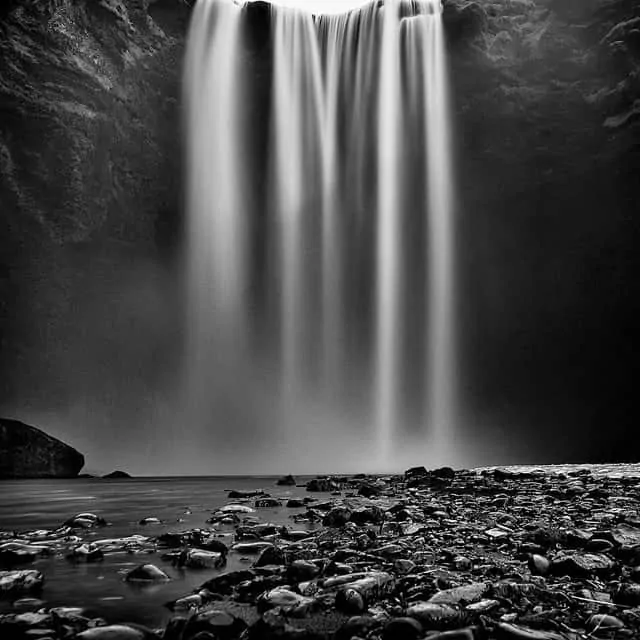What Percentage Of All The Earth Water Is Usable To Humans And Land Animals

There are 326 million cubic miles of endless bluish bounding main occupying the area between our seven continents, making upwards 70% of the earth's surface (Bureau of Reclamation, 2017).
With merely 5% of the ocean floor having been discovered and mapped, and with the deepest part reaching nearly seven miles, h2o seems to be as abundant as it is ominous.
Yet, it wouldn't take much of the mineral-rich ocean to dehydrate a homo beingness if consumed. The amount of sodium in seawater is much more full-bodied than what the trunk can safely process, requiring more water as common salt is consumed. Eventually, death would come up as a result of aridity without ever having the thirst quenched (Bounding main Service).
Of the waters occupying 70% of the earth's surface, just three% is considered freshwater. And almost of this freshwater reserve is inaccessible to humans — locked up in polar ice caps or stored also far underneath the world'south surface to be extracted. Furthermore, much of the freshwater that is accessible has become highly polluted.
This leaves united states with roughly 0.iv% of the earth'south water which is usable and drinkable to be shared among the 7 billion of its inhabitants (World Atlas, 2018).
How Much H2o is On Earth?

And still, much of this 0.four% is hard to get to. Most of it flows through undercover aquifers which tin be accessed by digging wells; the residuum are found in rivers and streams which we refer to as, surface water. Much of the global population is hard-stricken having admission to such a small percent of freshwater on the earth's surface (Perlman, 2016).

The U.s.a. Geological Survey provides a visual illustration (represented in spheres) every bit to the amount of available water in comparison to the size of the earth.
The largest sphere represents all of the water on earth (oceans, water ice caps, lakes, rivers, groundwater) and has a volume of 332,500,000 cubic miles.
The second-largest sphere, with a book of 2,551,100 cubic miles, represents the earth's freshwater supply in liquid form. 99% of the liquid freshwater is groundwater, much of which is far too deep to be attainable.
The rest of the world's freshwater exists in lakes and rivers, represented by the tiniest sphere, with a volume of 22,339 cubic miles (Perlman, 2016).
We utilise
0 billion gallons
of surface h2o per solar day
and
0 billion gallons
of groundwater per day
Since surface water is easier to attain, it'due south become the most common manner for humans to access clean water. Globally, we use virtually 321 billion gallons of surface water and about 77 billion gallons of groundwater per twenty-four hour period. Contamination of these water supplies is a problem that further limits availability (Groundwater Clan, 2012).
Surface Water
Surface water is any torso of h2o that is on the earth's surface: lakes, rivers, streams, and reservoirs. 80% of the world's daily water usage comes from surface h2o and makes up the majority of the water used for irrigation and public supply. Oceans are the world's largest source of surface water and brand up 97% of information technology, but due to its high salinity, information technology is unusable for humans (Postel, 2010).
The earth's surface waters travel through a circuitous network of flowing rivers and streams. Rivers can obtain their h2o from two sources: base menstruum and runoff. Base of operations menstruum is when the river collects its water from water-saturated areas in the ground, adding to its volume. Runoff is when the forcefulness of gravity naturally pulls water downhill from higher to lower altitudes. They commonly start as small creeks in the mountains, and then gradually merge with larger streams as they menstruation downwards, eventually forming large rivers which empty out into the ocean.
Groundwater
Groundwater is the water below the globe's surface that is at 100% saturation. Annihilation less than 100% is considered soil mixture. 98% of the globe's freshwater is indeed groundwater and it is about lx times more plentiful than the surface h2o. Groundwater travels through holes and cracks in the bedrock. The amount of stone space and the ability for water to travel through it is known every bit porosity and permeability. Groundwater with high porosity and permeability value tin travel quickly and are known as aquifers. An aquifer with loftier pressure can cause the groundwater level to rise to the surface once a well has been dug (Groundwater Association, 2012).
The Hydrologic Cycle
Water takes the form of liquid, gas, and solid and cycles through these in what is known as the world's hydrologic bike. When water evaporates, liquid molecules go gas molecules as they ascension through the atmosphere. Condensation begins when the moisture from these gas molecules becomes so great that they autumn back to earth in the form of atmospheric precipitation. Considering the process of evaporation, condensation, and precipitation has essentially "distilled" the h2o, it is considered clean before information technology hits the footing. When the precipitation hits the ground, it collects into aquifers, rivers, or lakes, ready to be used once more. Glaciers and icecaps cover 10% of the globe's mass and exist primarily in Greenland and Antarctica. They are the storehouses for the world's freshwater.
Water Conflicts Around the Earth

In that location are 263 rivers and countless aquifers worldwide which either cross or demarcate geopolitical boundaries. The Atlas of International Freshwater Agreement states that ninety percent of the earth's countries share these water sources with at least one or ii other governing bodies. The atrocities in Darfur are an instance of conflict resulting from clean h2o shortages.
• Violence erupts in 1992 over a dispute between Uzbekistan and Turkmenistan regarding the contested Tyuyamuyun reservoir. It continues to be a highly disputed water source in the region today (Factbook).
• In 2010, dozens of people were killed in Pakistan's tribal region due to a water dispute which lasted over two weeks. According to a senior government official in the Kurram district which borders Afghanistan, the Mangal tribe stopped water irrigation on lands belonging to the Tori tribe. In full, 116 people were killed and 165 were injured (CNN, 2010).
• Four farmers were hacked to death in northeast Tanzania over the disputed Pangani River Basin in 2013 (Factbook).
• In 2016, eighteen people were killed and 200 more than were injured when the Indian Army clashed with economic protestors surrounding the highly-contested Munak culvert, a h2o source that supplies New Dehli with three-fifths of its freshwater supply (Factbook).
• The drought-stricken conditions of major parts of Somalia often forcefulness herders to sell more of their livestock than they can afford to make a living with. This lack of economic stability fuels recruitment appeal with militant groups such as Al Shabaab, which provide cash incentives and other benefits to their soldiers. Other illicit activities such as pirating and livestock raiding are seen as reasonable alternatives to the failing stability of animal herding (Factbook).
Change is Needed
Water is finite. The amount of h2o circulating through the world'due south hydrologic cycle is the same amount that has been there since the world's kickoff, non a drop more or less. What has changed is the number of people living on earth, and thus, the amount of drinkable water required for man sustenance. The United Nations reports that in the concluding century lonely, h2o consumption has grown at more than twice the charge per unit of population increase.
70% of the globe is covered in h2o, yet only 3% of it is fresh. Of that 3%, ii.half-dozen of information technology is locked abroad in glaciers and polar ice caps. That leaves u.s.a. with 0.four% of the earth'southward water, in the form of rivers and underground aquifers, to try to utilize for our consumption and societal development. It is no wonder that in developing regions where clean water sources cross national boundaries, it often finds itself in disharmonize among those trying to secure a means to a healthy living.
With humans being made up of 60% h2o, our natural instinct might be to fight for it. But past collaborating to find ways to access the untapped groundwater beneath us, helping to conserve clean water use, and preventing farther pollution of our make clean water sources, it is possible for all peoples to have admission to clean water.
Thank you for taking the fourth dimension to read our commodity on answering the question: what is the per centum of potable h2o on world. We'd love to hear your feedback in the comments section below. If you've found this article to be useful and are interested in learning more, exist certain to sign up for our newsletter.
References
Agency of Reclamation. (2017, April 10). Water Facts - Worldwide H2o. Retrieved from https://www.usbr.gov/mp/arwec/water-facts-ww-water-sup.html
CNN. (2010, September). H2o conflict in Islamic republic of pakistan'due south tribal region leaves dozens dead. Retrieved from http://www.cnn.com/2010/World/meast/09/19/pakistan.water.dispute/
Factbook. (north.d.). Mapping environmental conflicts and cooperation. Retrieved from https://factbook.ecc-platform.org/
Groundwater Association. (2012, September). Information on Globe'south h2o - National Groundwater Association. Retrieved from http://www.ngwa.org/Fundamentals/teachers/Pages/data-on-globe-water.aspx
National Geographic. (2017, January 27). Competing for Clean H2o Has Led to a Crunch. Retrieved from https://www.nationalgeographic.com/environment/freshwater/freshwater-crunch/
Ocean Service. (due north.d.). Tin can humans beverage seawater? Retrieved from https://oceanservice.noaa.gov/facts/drinksw.html
Perlman, H. (2016, Dec 2). Where is Earth's h2o? USGS Water-Science School. Retrieved from https://water.usgs.gov/edu/earthwherewater.html
Perlman, H. (2016, December 2). How Much Water is on and in the Earth. Retrieved from https://water.usgs.gov/edu/gallery/global-water-volume.html
Postel, Due south. (2010, June). How Much Longer Until We Run Out of Enough Drinkable H2o? Retrieved from https://world wide web.alternet.org/story/147334/how_much_longer_until_we_run_out_of_enough_drinkable_water
Shahan, Z. (2017, October 24). How Much Make clean Water is Available for Human being Use? Retrieved from https://insteading.com/weblog/clean-water-human/
United Nations. (2007). Water scarcity. Retrieved from http://world wide web.un.org/waterforlifedecade/scarcity.shtml
World Atlas. (2018, February 14). What Percentage of the Earth'due south Water Is Drinkable? Retrieved from https://world wide web.worldatlas.com/articles/what-per centum-of-the-earth-s-water-is-drink.html
- Author
- Recent Posts
![]()
Source: https://worldwaterreserve.com/percentage-of-drinkable-water-on-earth/
Posted by: cappssomay1959.blogspot.com

0 Response to "What Percentage Of All The Earth Water Is Usable To Humans And Land Animals"
Post a Comment